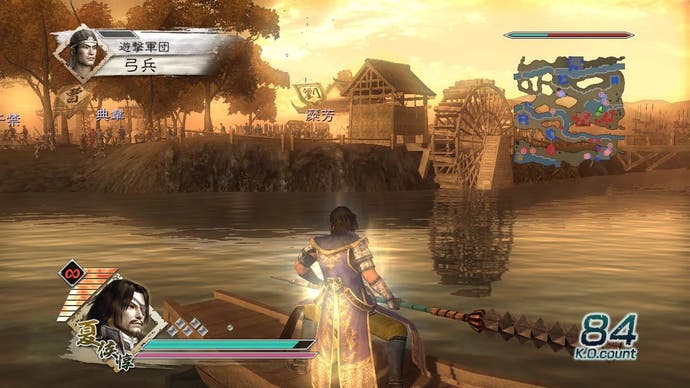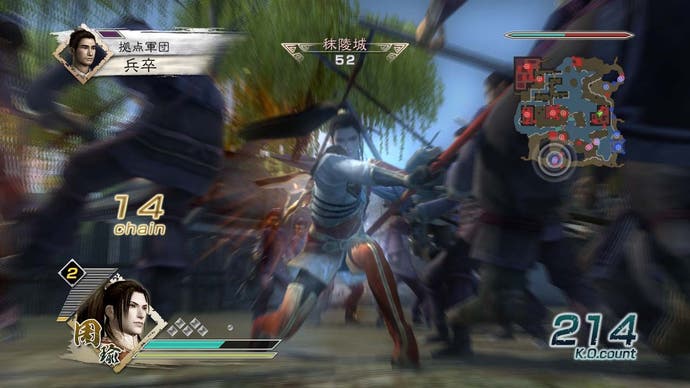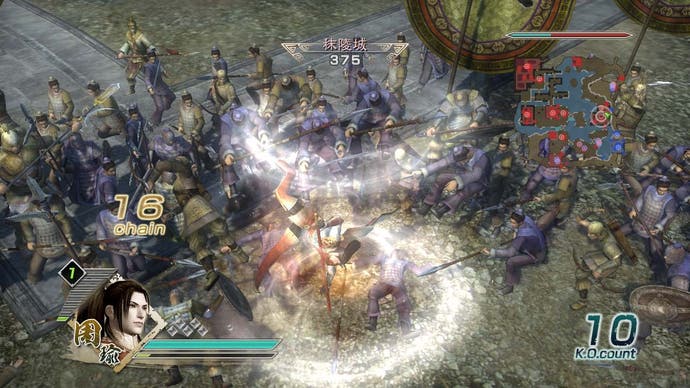Dynasty Warriors 6
The best of Koei's battlefield brawlers yet.
Honestly, these Dynasty Warriors reviews almost write themselves: Dynasty Warriors is, once again, the game that launched a load of consoles. In the week that Dynasty Warriors 6 (or Shin Sangokumusou 5 as it's known over there) came out in Japan, sales of the PS3 eclipsed the Wii. That's the same sort of sales spike that was triggered by Gundam Musou when it came out, and Dynasty Warriors 2 when it was released back in the early days of the PlayStation 2. And yet - as I point out at the start of every one of these reviews - here in the west, gamers remain resolutely impervious to the unique charms of Koei's battlefield blend of strategy, action, terrible voice-acting, and mental haircuts. And so I ask the same question that I do at the start of every one of these reviews: is this the one that'll fare any differently?
I'm afraid I can't give you an answer to that, because I haven't got a crystal ball, and because (to judge from sales charts the world over) the gaming public has about as much sense as a demented squirrel. What I can say is that to the untrained eye, Dynasty Warriors 6 remains broadly similar to previous instalments: pick one of umpteen different warriors, and fight your way through battlefields full of swarming enemy soldiers, performing combat histrionics across the milieu of the Romance of the Three Kingdoms (and if you don't know what that is: where the heck have you been for the past 16-odd games?).

The most obvious difference is (duh) the visual improvement. Now that it's in high definition, a series of swooshing camera effects and spangly new animations bring the game more dramatically to life than ever before. Duels with enemy officers see surrounding troops blur into the background, Musou attacks are accompanied by a kaleidoscopic symphony of colour, and character animations are modelled on motion-captured martial artists, making them more convincing, more acrobatic, and generally just more insane. The most commonly levelled criticism of the series - bad guys emerging out of the mist - remains to some extent, except there's no mist. But that's because there's more bad guys (by three or four times, apparently) and in any case, they behave more intelligently than in previous games (though still not as intelligently as the cutting-edge AI you'd find in the latest one-on-one beat-'em-up - so, no doubt, critics who have missed the point will still moan about it).
To the trained, Dynasty Warriors-hardened eye, however, things are very different. There are all sorts of tweaks and new features that will only matter to people who have immersed themselves in the series so far. Now you can climb ladders, swim through water, ride boats, and smash through gates to reach strongholds that play a slightly more important role than before (and can be captured after you've eliminated any officers present). Some of the battlefields are populated with fearsome animals and certain characters are equipped with different weapons. And your character levels up in the midst of battles, though it's only at the end of battles that you get to assign points in order to progress along a multi-branching skill tree.

Most people reading this will probably greet those differences with nothing more than a metaphorical shrug of the shoulders and a slightly confused and nonplussed 'whu?', but the upshot of all these new moves and minor tweaks is that battlefields now open up as they've never done before, affording a much greater degree of tactical freedom and allowing missions to be approached in a multitude of different ways. The first time you swim across to a bit of the map that would have been unreachable in the old days, or jump down into the middle of a swarm of unwitting troops below, or climb up onto the ramparts, is a moment of particularly satisfying epiphany.
The most substantial difference, however - and improvement - is the new Renbu system. Essentially, performing combos repeatedly, without getting knocked down, ramps up your Renbu, which then allows you access to a wider range of moves, unlocks weapon-specific effects, and, ultimately, enables unending combos. The result is a combat system that, in terms of speed and fluidity, is more akin to Gundam Musou than previous Dynasty Warriors games, and more like a conventional beat-'em-up in the depth of its range of moves. Indeed, combine it with those baton-twirling, salmon-leaping mo-capped martial arts moves, and while it's not quite Devil May Cry territory, in terms of stylish action and over-the-top acrobatic verve it's certainly approaching it. So while the game retains its broad strategic sweep and tactical challenge, it's also more like a balls-out action game than any previous episode of the series.

Other things that are worth mentioning are the return of Koei's characteristically sumptuous cut-scenes; a database containing all the trainspotterish detail you could ever want about the Romance of the three Kingdoms; a challenge mode containing a succession of speed or KO-count type tasks; and a base camp where you can survey the progress you've made across all of your unlocked characters, weapons and horses. The game features 19 different stages but you're restricted to marginally fewer characters than the last game in the series, with only 17 different character campaigns (and consequently, the game probably takes slightly less time to completely crack open).
None of that will matter, of course, to the non-Dynasty Warrioring gaming public. If you're one of them, maybe you should focus, instead, on the simple fact that Dynasty Warriors 6 is absolutely up there with the best of the series so far. It's as good as the game has ever been, and so there's never been a better time to try it out. And if it's still not for you, well then it's still not for you, but at least you tried. If you are one of the Dynasty Warrioring gaming public, you will buy this and love this. So it's a good job Koei keeps trying.
